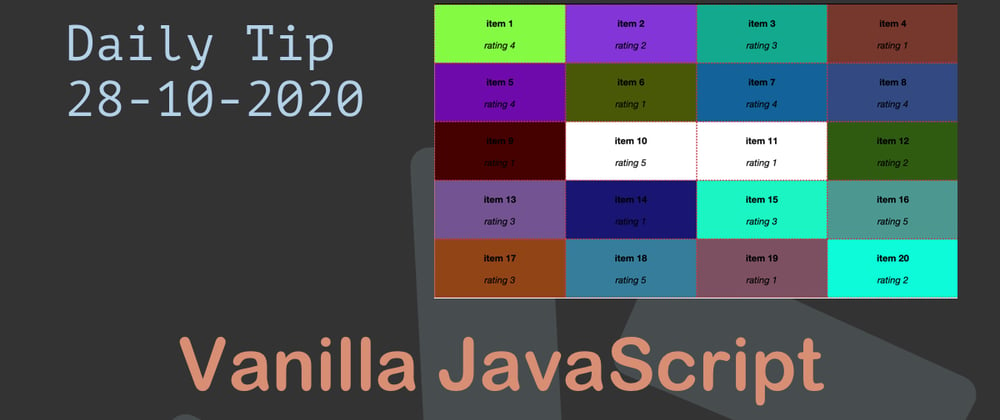Ever wondered how you can create random colours using Vanilla JavaScript?
The other day we made a JavaScript data-attribute filter, and I wanted to give each block a random colour.
So today we are going to do just that.
The end result will be as this Codepen (Open or reload to see random new colours)
JavaScript random hex colour
In our example, we will be generating a random hex number. These can be any six-characters from 0-9 and A-F.
Luckily in JavaScript, it's even easier to create a random hex string.
Let's break it down.
Math.random()*10000000
This will give us a random number which will look like this:
2773929.134011086
9192315.941572387
The next step is to floor this number to we will only get the first part.
Math.floor(Math.random()*10000000)
Which would result in the following for the above examples:
2773929
9192315
Now we need to create strings else we would only have numbers and one too many.
We can use the toString() method and specify the radix parameter as 16.
This will convert 254 to fe, for instance.
Math.floor(Math.random()*10000000).toString(16)
This will get results like:
'2a53a9'
'8c437b'
Awesome, Perfect hex values!
Random colour blocks in JavaScript
Now let's give our blocks all a random colour.
<ul>
<li data-rating="4"><span>item 1</span><i>rating 4</i></li>
<li data-rating="2"><span>item 2</span><i>rating 2</i></li>
<li data-rating="3"><span>item 3</span><i>rating 3</i></li>
<li data-rating="1"><span>item 4</span><i>rating 1</i></li>
<li data-rating="4"><span>item 5</span><i>rating 4</i></li>
<li data-rating="1"><span>item 6</span><i>rating 1</i></li>
<li data-rating="4"><span>item 7</span><i>rating 4</i></li>
<li data-rating="4"><span>item 8</span><i>rating 4</i></li>
<li data-rating="1"><span>item 9</span><i>rating 1</i></li>
<li data-rating="5"><span>item 10</span><i>rating 5</i></li>
<li data-rating="1"><span>item 11</span><i>rating 1</i></li>
<li data-rating="2"><span>item 12</span><i>rating 2</i></li>
<li data-rating="3"><span>item 13</span><i>rating 3</i></li>
<li data-rating="1"><span>item 14</span><i>rating 1</i></li>
<li data-rating="3"><span>item 15</span><i>rating 3</i></li>
<li data-rating="5"><span>item 16</span><i>rating 5</i></li>
<li data-rating="3"><span>item 17</span><i>rating 3</i></li>
<li data-rating="5"><span>item 18</span><i>rating 5</i></li>
<li data-rating="1"><span>item 19</span><i>rating 1</i></li>
<li data-rating="2"><span>item 20</span><i>rating 2</i></li>
</ul>
Now we need to get all our list items and loop over them.
const elements = document.querySelectorAll("li");
[...elements].forEach((element) => {
element.style.backgroundColor = "#" + (Math.floor(Math.random() * 1e7).toString(16));
});
It might not have the prettiest colours, but at least they're random!
You might have noted the 1e7 which is a shorthand Decimal Base Exponent.
It means one followed by seven zeroes.
Thank you for reading, and let's connect!
Thank you for reading my blog. Feel free to subscribe to my email newsletter and connect on Facebook or Twitter







Oldest comments (8)
You'll get a more complete distribution throughout the RGB color space using
0x1_00_00_00(decimal 16,777,216) as a multiplier, rather than1e7(decimal 10,000,000).Math.randomis inclusive of the lower bound but not the upper bound, soMath.floor(Math.random() * 0x1_00_00_00)gives a number in the range0x00_00_00..0xff_ff_ff(pure black to pure white).1e7 - 1(the maximum value with1e7as upper bound), on the other hand, converts to0x98_96_7f, which is a sort of beige color.I think that's why the colors you're generating are skewing toward greens and purples, bearing in mind that contiguous 6-digit hex numbers don't always look like similar colors, seeing as they're split into red-green-blue segments.
You'll still have a chance to hit a number low enough not to yield a 3- or 6-digit hex number, which will result in an invalid color (0x0-0xFF, 0x1000-0xfffff). To solve that, you can use
instead.
Good point, forgot about that. A simpler fix would probably be
hexStr.padStart(6, '0').Good point, it's not a failsafe method indeed thanks for this addition Lionel!
Hey, Chris!
I've actually made a few things with random colors both with hex and RGB. I think the RGB approach is a bit easier. Especially for newbies.
Here is a simple example:
codepen.io/Hellnar/pen/JjKMzzm
But anyway thanks for sharing your option. Also very nice and clean.
True RGB(a) might be easier to understand for most people because it's easier to calculate with, nice one Stan!
This looks like a super fun one. Very innovative and elegant solution 👍
Thanks Waylon, as mentioned there are many ways of doing it in the comments as well.